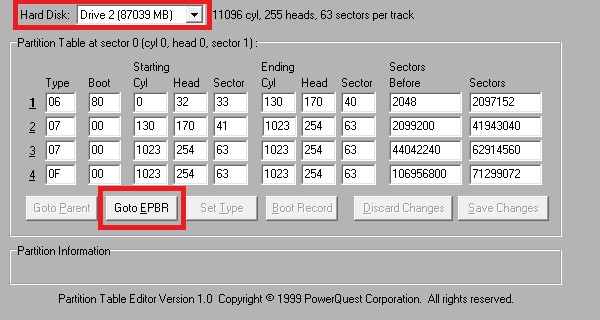What I did was download PTEDIT32.EXE and made the PQService (where the factory default image is) appear in 'My Computer'. Then I downloaded and installed another non-OEM disk of Windows Vista Ultimate because I needed to install Acer eRecovery (Does not install Xp). Find PowerQuest software downloads at CNET Download.com, the most comprehensive source for safe, trusted, and spyware-free downloads on the Web.
| Links to Apps Mentioned on the Site |
MBRWizard HxD PTS-Disk Editor Ultimate Boot CD - (UBCD). EasyBCD VistaBootPro Partition Table Editor - ptedit.exe and ptedit32.exe Gparted
|
four physical drives. For example if you already have two hard disks:
(hd0)
(hd1)
then on vdk start you get (without knowing it):
(hd0) *
Ptedit32
(hd1) *(hd2)
(hd3)
(hd4)
(hd5)
(*) means real disk (disk ready).
(hd0) is equivalent to dsfo/dsfi notation of .physicaldrive0.
(hd1) is equivalent to dsfo/dsfi notation of .physicaldrive1..
Usually you will use vdk open/link to assign to a hard disk image. By default vdk drive 0, so you get:
(hd0) *
(hd1) *
(hd2) *
(hd3)
(hd4)
(hd5)
Now if you use ptedit32 you will see ONLY the first 3 disks with their associated size :
(hd0) * size0

(hd1) * size1
(hd2) * size2
If you use beeblebroxNT you will see all hard disks but no distinction of which one is really ready:
(hd0)
(hd1)
(hd2)
(hd3)
(hd4)
(hd5)
With beeblebrox if you choose e.g. (hd3) you will get some popup errors since the drive is not ready.
The best is using grubinst_gui.exe (part grub4dos-0.4.3 or later package). In its combo-box for drive,
you will see:
(hd0) * size0
(hd1) * size1
(hd2) * size2
(hd3)
(hd4)
(hd5)
which is the perfect display since it told you what disks are ready.
Now if you plug an external HDD or USB key, there will a .physicaldrive6 (hd6) assigned,
but this disk will NOT appear under ptedit32, since apparently it stops at first not ready drive.
grubinst_gui.exe display is execellent since it continues all physical drives emuneration:
(hd0) * size0
(hd1) * size1
(hd2) * size2
(hd3)
(hd4)
(hd5)
(hd6) * size6
Personally I prefer ptedit32 to beeblebrox (hard disk size identification), but you must be aware of
Ptedit32 Download Free
'missing' physical disks due to vdk reservation gap.To eliminate the gap (hd2)-(hd5) you have to issue a vdk close (or of course vdk remove).
Then you need to unplug the HDD (hd6) to free this slot, replug it (so it will be assigned (hd2)) and it
will be seen by ptedit32 and hence usable.
The above lines could be a little confused but I hope forum specialists have no problem reading it. :-)
